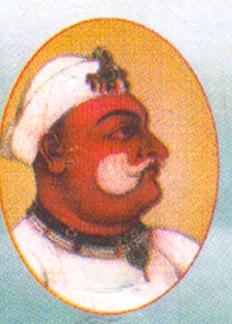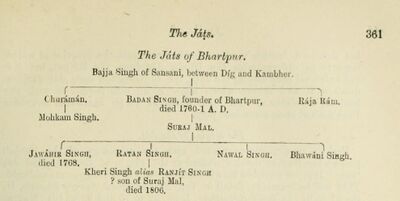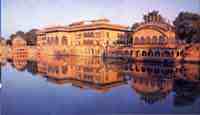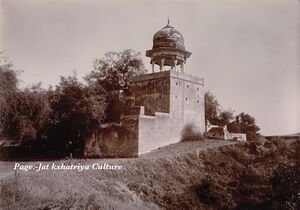Badan Singh
| Author:Laxman Burdak, IFS (R) |

Badan Singh (बदन सिंह) (1722 – 1756) was the formal founder of the princely state of Bharatpur (भरतपुर). He was nephew of Churaman. After the death of Churaman on 22 September 1721 there were family disputes between Badan Singh and Mohkam Singh, son of Churaman. Badan Singh aligned with Jai Singh of Jaipur to avoid the anger of Mohkam Singh. In this family feud Jai Singh supported Badan Singh.
Genealogy of Badan Singh
Bhuri Singh (Sinsini) → Ruria Singh (Sinsini) → Khanchand (Sinsini) → 1. Bhajja Singh + 2. Brij Raj
Bhajja Singh (r.1688-1691) → Raja Ram (b.?, r.1670 – 1688)
Brij Raj (d.1682) → 1. Churaman + 2. Bhao Singh (d.1682)
Churaman → Muhkam Singh (Thun)
Bhao Singh (d.1682) → Badan Singh (b.?, r.1722 – 1756) (Deeg) → 1. Suraj Mal (Bharatpur) +2. Pratap Singh (Weir)
Thakur Badan Singh
Ram Sarup Joon[1] writes that ... Thakur Badan Singh had conspired against his uncle Churaman and helped Raja Jai Singh in subjugating Jats. Consequently the title of Thakur was conferred upon Badan Singh by Raja Jai Singh and he was placed on the throne as a successor to Churaman. Badan Singh was an opportunist and after getting the power, did not remain loyal to Raja Jai Singh. He started consolidating his power and soon got rid of the domination of Jaipur and Ajmer. With the alliance of the Minas of Mewat, he started hostilities against Jaipur state. Raja Jai Singh found himself in a perilous situation due to Badan Singh's regular harassment. He tried to appease Badan Singh by giving him a Jagir with an annual income of 18 Lakhs. Thakur Badan Singh ardor cooled down and he constructed a fort at Vaer with this remuneration. At this time Nadir Shah invaded the Moghuls. Badan Singh exploited the opportunity and occupied several Moghul forts. He strengthened diplomatic relations with the Rathore Rajas. Abhai Singh and Ajit Singh, of Bundi who gave him the title of Brij Raj. The title was recognised by all the Rajas of that area.
Thakur Badan Singh, Founder of the Ruling House of Bharaipur
K. R. Qanungo[2] writes that ....[p.35]:Thakur Badan Singh, father of Suraj Mal, started his career as a feudatory of Sawai Jai Singh of Amber (Jaipur), who had given him the lands and title of Churaman Jat in the reign Of the Emperor Muhammad Shah. Unlike his notorious uncle, he was a quiet and politic man, having no taste for a predatory life. He set up a legitimate ruler, sincerely desirous of promoting the arts of peace. He believed more in the steady expansion and consolidation of his dominions than in erratic and slippery conquests. The task which he took upon himself was not a light one; it meant transforming a robber-chief's "sphere of influence" into an orderly principality with a regular government. In this however, he succeeded eminently after years of patient toil and tactful administration. We do not hear of any diplomatic activity or brilliant exploit of arms on his part. Nevertheless,it is clear that within a few years of his accession, he grew powerful enough to shake off his dependence upon Amber. Badan Singh, then uniting himself with the rebels of Mewat, carried raids into the territories of the Raja of Jaipur, who had to conciliate him by a grant of lands, yielding 18 lakhs of Rupees a year.1 Taking advantage of the confused state Of affairs, he made some acquisitions in the Bayana district and built a fort at Wair, which was given to his youngest son Pratap Singh. His greatest achievement was the establishment of the authority of his house over almost the whole of the Agra and Mathura districts, partly by posing
1. Imad-us-Saadat, p. 55.
[p. 36]: as the protector of the Hindus against Muslim misrule, but mainly by clever matrimonial alliances with some powerful Jat families of those places. He married the daughter of a wealthy and influential Jat of Kamar,2 Chaudhuri Maha Ram (चौधरी मोहनराम) and took another wife from the laird (Zamindar) of Sahar. These marriages made him virtually the master of the entire Mathura district.
In the eyes of the Mughal Government, Badan Singh was still a plebian rebel who deserved the severest punishment, if only the corrupt and effete Court of Delhi could inflict it. Had Nadir Shah decided to stay in Hindustan a few months more, or made his intended pilgrimage to Ajmer3 the Jat chief would have been the first to feel the weight of the Persian's arm. Since his departure the timid gaze of the Mughal Court was mainly fixed on the north-west. In the meanwhile, Thakur Badan Singh silently consolidated his authority over many outlying districts, wiout much difficulty. People welcomed him because he meant to rule and not plunder them like his predecessors. His one dear object was to secure the title of Raja, and for this, he was even ready to bow before the imperial throne, which he could otherwise have safely defied. But he was not successful, perhaps owing to the jealousy of the ruler of Jaipur, who affected to look upon the Jats as his subjects. It was perhaps from this time that the ruling house of Bharatpur openly laid claim to the Yadava lineage and the title of Braj Raj, a claim if not sanctified by past tradition, at least justified by their complete sway over what is known as Brij-mandal or the Mathura region. Ajit Singh and Abhai Singh of Marwar, it is said, used to address Badan Singh as Raja. His ambition was certainy flattered, when he was invited to the Ashvamedha4 sacrifice of Mahara a Sawai Jai Singh, and the honour of a prince was accorded to his son Suraj Mal. Undoubtedly, Badan Singh worked and lived in a manner to deserve that title. He kept Court with adequate grandeur.
2. Kamar (lat. 27°- 50"; long.77° - 30'] is near Kosi in the Mathura district about 33 miles n.w. of Mathura. Sahar 18 miles n.w. (lat. 27° - 40'; long. 77°-44', ]. Growse, Mathura p. 23.
3. Irvine's Later Mughals, ii, 374.
4. Jawala Sahai's History of Bharatpur.
[p.37]: Several Muhammadan officers whom he had taken in service brought the requisite polish and dignity into his Court and served there as models of Court-life and teachers of etiquette to his rough tribesmen. His growing predilection for Islamic culture and aristocratic training became prominent in the education of his youngest and most beloved son, Pratap Singh.5
Badan Singh's taste for architecture:
-
Old Palace or Chaupal at Deeg Fort.
Badan Singh had some aesthetic sense and a taste for architecture too, which is testified by the remains of his numerous buildings and garden-palaces. He beautified the fort of Deeg with handsome palaces, which are known as the Purana Mahal.
At Wair in the Bayana district, he planted within the fort a large garden with a beautiful house and reservoirs in the centre, now called Phul-bari.
He also built palaces at Kamar as well Sahar, which are now in ruin, and dedicated a temple at Brindaban, known by the poetic name of Dhir Samir.6
Badan Singh lived to a ripe old age, which he spent in happy retirement at Sahar, leaving the management of his State to his most capable son Suraj Mal. He died on the 9th of Ramzan, 1169 A.H. - 7th June, 1756 (Waqa, 133) under the usual suspicion of being poisoned, though there was no imaginable ground for it.
5. The author of Imad-us-Saadat tells us that this young man grew up (in airs and graces) a high-bred Muslim grandee with good manners and elegant speech. In the sytle of tying his turban, the fashion of his dress as well as his favourite dishes, he imitated the manner of Delhi. Bahadur Singh, son of this Pratap Singh, went a step ahead of his father. He took to the study of the Quran and read up to the Sura Jami. Imad, 55.
6. Growse, p. 139.
Wives and Sons of Badan Singh

Girish Chandra Dwivedi[3] mentions....Badan Singh, with a view to enhancing his power and position, almost like Tudor Henry VII of England, contracted political marriages in the families of the leading chieftains such as those of Kama and Sahar and possibly of Salempur, Hodal, Bachhamadi and Pathena.
Badan Singh had many Queens and of his several sons only Suraj Mal had six (almost all of them married during the life time of Badan Singh). It is not possible to state how many of these were received in marriage, we keeping the above object in view. The places Cited above were owned by those chiefs, who, are told, had married their daughters with Suraj Mal. [4]
Girish Chandra Dwivedi[5] mentions....Vijay Ram Garasia, the chief of Pathena, being a close associate of Churaman and his sons, had in the past and still opposed Badan Singh. In an attempt to bring the Garasia close to him, he married Suraj Mal with his daughter, Kalyan Kaur (Kalayani). [6] But this conciliatory step failed to mend his ways. Thereupon, he granted Pathena as a jagir to Shardul (the son of Ati Ram of Halaina) whom he had earlier won over to his side. Shardul killed Vijay Ram and held Pathena under Badan Singh. [7]
Sons of Badan Singh: Badan Singh had issue, 26 sons. The list is as under:
- Maharaja Suraj Mal
- Kanwar Pratap Singh
- Kanwar Akhai Singh
- Kanwar Balram Singh
- Kanwar Bijay Singh
- Kanwar Birnarayan Singh
- Kanwar Dalel Singh
- Kanwar Duleh Singh
- Kanwar Devi Singh
- Kanwar Guman Singh
- Kanwar Himmat Singh
- Kanwar Jodh Singh
- Kanwar Khushal Singh
- Kanwar Khem Karan Singh
- Kanwar Lal Singh
- Kanwar Man Singh
- Kanwar Medh Singh
- Kanwar Udai Singh
- Kanwar Sultan Singh
- Kanwar Sukh Ram Singh
- Kanwar Sakat Singh
- Kanwar Sabha Ram Singh
- Kanwar Ram Kishan Singh
- Kanwar Ram Bal Singh
- Kanwar Ram Prem Singh
Badan Singh became Brijraj
On 18 November 1722 the Rajput Mughal combined army besieged the Thoon fort of Mohkam Singh, took it and got it ploughed by Asses. Thus the Jat state of Badan Singh rose from the asses of Thoon, Jatauli and other forts.
After the fall of Thoon and Jatauli, Badan Singh became formally a samant of Jaipur Darbar on 23 November 1722. Jai Singh in exchange honoured Badan Singh with the title of ‘Brijraj’ i.e. the king of Brij. He was permitted the use of ‘Nagara’, ‘Nishan’ and ‘Pachrang flag’ and gave the Kotwali of Agra. Besides, he was also given the Jagirs of Mathura, Vrindavan, Mahavan, Hisar, Chhata, Kosi and Hodal parganas for revenue of Rs. 50-60 lakh.
Expansion of the state
Badan Singh was not given the entire area in occupation of his uncle Churaman and his sons. He was only thakur of Deeg. Even then he maintained patience, political balance and loyalty to Jai Singh. He was clever enough to understand the circumstances of those times.
Badan Singh planned to win over the confidence of his own Jat community and at the same time maintaining a balance with Rajputs and Mughals. With this vision he established his permanent residence and office near Deeg. After this he planned to make friendly relations with the influencial zamindars and sardars of the Jat state. To implement his plan he married his most competent son Suraj Mal to Hansia, the beautiful daughter of most influencial Chaudhary of Jatwara Ratiram. He recruited all the people in the army of Mohkam Singh in his own army. Badan Singh himself established marital relations with chiefs of various groups. He had 25 Queens. This helped him to increase his influence. He took in his side not only Jats and Rajput groups but also Brahmans. He awarded titles like Faujdar, Bakhshi and Sardar to many powerful people to take them into his side. He also allured the Gujars of Deeg and Nagar parganas by awarding them with the title of ‘Dhau’. This way he became an undisputed leader of mass over vast areas.
Khemkaran Sogaria who was a close associate of Churaman was still against him. This problem was solved by his young son Suraj Mal. Suraj Mal eliminated Khemkaran and acquired Sogaria pargana from Khemkaran. Badan Singh also acquired 31 villages of Agra and the Jat dominated Kagaraul pargana on lease. With such a tact and vision Badan Singh could expand his state bigger than that of Churaman within a decade.
Role of Jai Singh
In this success there was a great contribution of Jai Singh. Jai Singh was governor of Agra Suba. Badan Singh often visited Jaipur Darbar as per Royal customs on the occasion of Dashhara by presenting gifts. He also constructed a palace in Jaipur for his residence. That area is known as Badanpura even today. Badan Singh never visited the Mughal Darbar even after inviting many times. He called himself a thakur and never treated himself as Raja. It was with a view to respect the feelings of people and protects his own self-respect.
Inclusion of Mewat
Mev people inhabited areas surrounded by hills near the northern boundary of Bharatpur state. They were creating problems for people by looting them. Jai Singh also wanted to control them. The task of solving this problem was assigned to his son Suraj Mal and a close relative thakur Sultan Singh. They did it successfully. Surajmal was tactfully eliminating the Amils of Jaipur state and establishing his own Thanas. Badan Singh got the Jagir of Mewat for revenue of Rs. 18 lakh per annum.
The battle of Mandu 1729
Sawai Raja Jai Singh of Jaipur got the Subadari of Malwa in October 1729. He was ordered to move against the Marathas. The Kachwahas showed a great courage in the war against Marathas. Jats took part in this war against Marathas under the leadership of Suraj Mal. At the end of 1729 the Marathas were defeated in this war and Mandu came under Jai Singh.
The battle of Bhopal 1737
Sawai Raja Jai Singh sent the army against Peshwa Bajirao to help Nizam-ul-mulk under the leadership of his son Iswari Singh and Diwan Raja Ayamal. Badan Singh also sent Jat army in support of Jai Singh under the leadership of his second son Pratap Singh. There was a fierce battle on 24 December 1737 in which Nizam-ul-mulk was badly surrounded. At last on 6 January 1738 Peshwa Bajirao was forced to make a treaty with Jai Singh at village Doraha near Bhopal.
Gangwana war 27 May 1741
On 7 May 1741 when Jai Singh was busy in negotiations with Peshwa Balaji Bajirao in Dholpur, he received information about Bakht Singh Rathore's planning of attack on Amber. Jai Singh returned with an army of 50000 people. This army included Jats also. There was encounter by Bakht Singh with the army of Jai Singh at place called Gangwana near Ajmer. This battle was fought on 27 May 1741. Jat army took part in this battle under the leadership of Suraj Mal. Bakht Singh was defeated.
Retired from state affairs
Badan Singh had 20 sons. Out of them Suraj Mal and Pratap Singh were competent and popular. To avoid any family feud in future Badan Singh got constructed separately strong forts and palaces at Kumher for Suraj Mal and at Weir for Pratap Singh. It is believed that due to his health conditions Badan Singh handed over the state of Weir to Pratap Singh around 1738-40 and declared Suraj Mal as successor for the rest of state and handed over the administration to him. Due to untimely death of his son Pratap Singh on 2 November 1745 and severity of his eye problem he decided to retire from active royal affairs. In November 1745 Suraj Mal became the ruler of Jat state.
Last Period of Badan Singh
Badan Singh spent the last period of his life in Deeg and Sahar. He had inclination for art and architecture since beginning. Natwar Singh has mentioned that Badan Singh had extraordinary sense of beautification even though he was illiterate. According to him the grand layout of palaces and gardens of Deeg was entirely that of Badan Singh.

Badan Singh did the beautification of Deeg Fort. The palaces constructed by him at Deeg are known as 'Purana Mahal'. He got constructed Parkotas around Kumher and Weir towns along with new construction of buildings in forts. Sahar was his place of choice so he got constructed beautiful buildings and developed gardens there. He also got constructed a temple at 'Dhir Samir' ghat of Vrindavan.
Badan Singh himself was a poet and encouraged poets. He brought famous poet Somnath from Mathura and appointed as teacher of Suraj Mal.
The craftsman of Agra had become jobless due to the meager financial conditions of Mughal ruler. Badan Singh brought these craftsman from Agra and gave them work. He also engaged large number of people in works like digging of ponds, making bricks, developing grass lawns etc. There was nobody without work in his state. Badan Singh died on 7 June 1756 at Deeg.
Assessment of Badan Singh
Badan Singh was the formal founder of the princely state of Bharatpur. Badan Singh expanded his state through vision and political tacts. He believed in piece rather than war and bloodshed. The people in his state were safe. He has great contributions for the architecture, art, poetry and craftmenship.
Chhatri of Maharaja Badan Singh at Deeg

Chhatri of Maharaja Badan Singh at Deeg, Rajasthan. This Chattari built by his Son Maharaja Suraj Mal (Also known as Sujan Singh). The chhatri is a cenotaph, a memorial to Badan Singh, and takes the form of a domed pavilion that stands on an elevated square platform approached by a flight of steps.
Photograph from the Curzon Collection, of a chhatri in the fort at Deeg, Rajasthan, taken by the studio of Priyalall & Company in c.1900. Deeg was established as the First capital of Bharatpur State after Thoon by the Sinsini Jat ruler Maharaja Badan Singh.
Source - Jat Kshatriya Culture
राजा बदनसिंह

ठाकुर देशराज लिखते हैं कि सवाई महाराज जयसिंह जी से इनका बड़ा मेल-जोल था। अधिकांश समय उनका जयपुर ही में बीतता था। जयपुर में उनके नाम से एक स्थान बदनपुरा भी है। संवत् 1775 में यह डीग के मालिक बने। डीग में उन्होंने अच्छी-अच्छी इमारतें बनवाई और कुम्हेर में सुदृढ़ दुर्ग का निर्माण कराया।
राजा बदनसिंह लड़ाई-झगड़े की अपेक्षा राज्य-व्यवस्था में अधिक संलग्न रहे।
जाट इतिहास:ठाकुर देशराज,पृष्ठान्त-639
फिर भी उन्होंने अठारह लाख की आमदनी का जयपुर का इलाका प्राप्त कर लिया और कुछ हिस्सा आगरे की ओर दबा लिया। कामर के सरदार चौधरी मोहनराम और सहार के रईस की लड़की से शादी करने के कारण इनका प्रभाव मथुरा जिले पर हो गया था। आपने अपने दूसरे पुत्र प्रतापसिंह को वैर का मालिक बनाया। महाराजा सूरजमल इनके सभी पुत्रों में श्रेष्ठ थे। अठारह लड़कों की संतानें कोठरी-बन्द के नाम से मशहूर हैं। आपको जयपुर के महारज जयसिंह सवाई ‘ब्रजराज’ कहा करते थे।30
राजा बदनसिंह जी का स्वर्गवास संवत् 1812 विक्रमी में हुआ था। उस समय श्री सुजानसिंह उपनाम सूरजमल जी 22 वर्ष के थे।
Further reading
- Dr Natthan Singh: Jat - Itihas (Hindi), Jat Samaj Kalyan Parishad, Gwalior, 2004
- Thakur Deshraj: Jat Itihas (Hindi), Maharaja Suraj Mal Smarak Shiksha Sansthan, Delhi, 1934.
- Dr. Prakash Chandra Chandawat: Maharaja Suraj Mal aur unka yug (Hindi), Jaypal Agencies Agra, 1982
- G.C. Dwivedi: The Jats - Their role in the Mughal Empire
External link
References
- ↑ Ram Sarup Joon: History of the Jats/Chapter X,p.159
- ↑ History of the Jats:Dr Kanungo/Expansion of the Jat Power,pp.35-
- ↑ The Jats - Their Role in the Mughal Empire/Chapter V,p.97
- ↑ Vide Tawarikh-i-Hunud, 22a-22b, 26b; Pathena Raso, quoted by Ganga Singh, op.cil., 100; Memoires des Jats, 63, cf. TAH. 23a.
- ↑ The Jats - Their Role in the Mughal Empire/Chapter V,p.100
- ↑ Tawarikh-i-Hunud, 22b
- ↑ Pathena Raso, Quoted by Ganga Singh, op. cit., 100-101,91
Back to The Rulers



